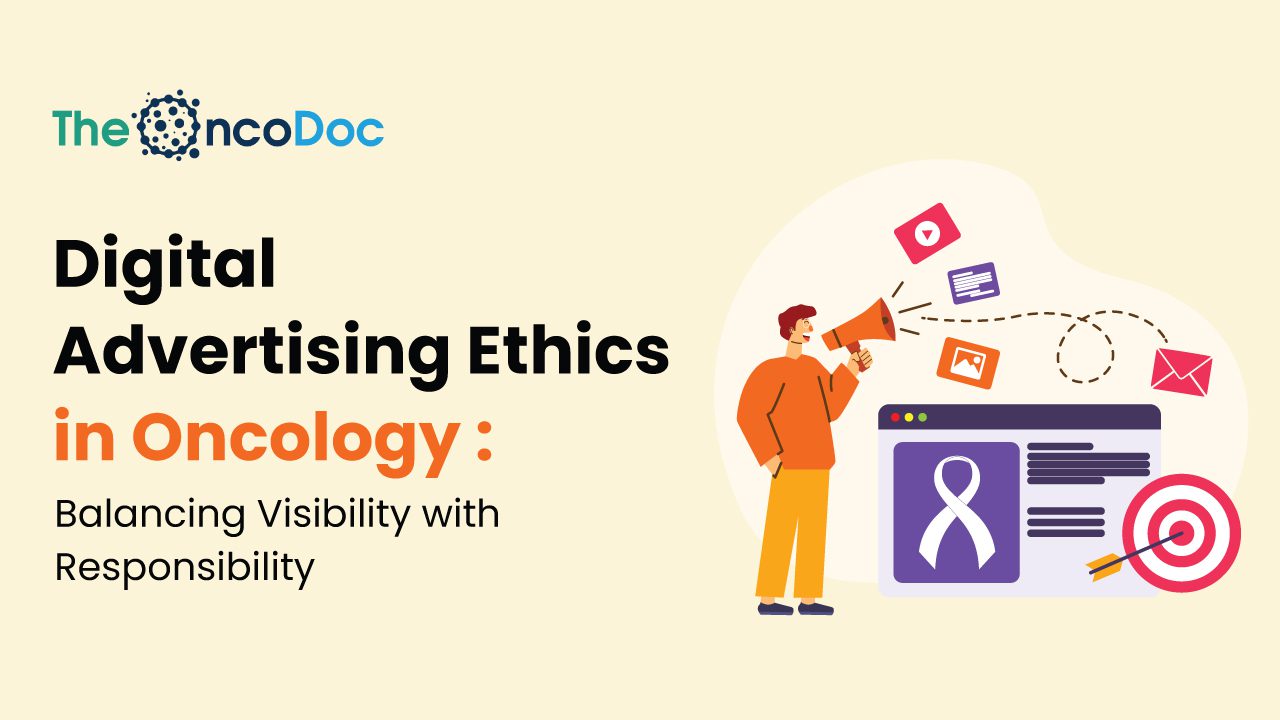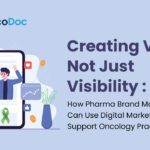Introduction: Walking the Ethical Tightrope in Cancer Care
In today’s digital-first world, even the most critical and sensitive health decisions begin with a search bar. Patients facing a cancer diagnosis or even a suspicion turn to the internet for answers, reassurance, and guidance. In this environment, digital advertising becomes a powerful tool for oncologists to educate, engage, and ultimately help patients access care. But with this power comes immense responsibility.
Unlike cosmetic procedures or general wellness campaigns, oncology advertising cannot afford to rely on flashy slogans or manipulative clickbait. Each impression or click may represent someone navigating a personal health crisis. Misusing digital platforms for cancer marketing risks not just ethical breaches but the erosion of trust- a core element of patient care.
This article explores the complex intersection between digital visibility and ethical responsibility in oncology, outlining both the pitfalls and the principles that can help ensure every message upholds patient dignity and medical integrity.
Why Ethical Standards Are Essential in Oncology Advertising
Cancer is not a consumer choice- it’s a life-altering condition. When people search for oncologists or treatment centers, they do so with vulnerability and urgency. Digital marketing in oncology must therefore be held to a higher ethical standard.
Ethical advertising matters because it:
- Supports informed decision-making, not pressured conversions.
- Preserves trust between the public and medical institutions.
- Protects vulnerable individuals from exploitation or fear-mongering.
- Upholds the reputation of oncology as a compassionate, evidence-based field.
Patients aren’t looking for hype- they’re looking for hope, clarity, and reliable care. Ethical marketing ensures you deliver just that.
Common Ethical Pitfalls in Oncology Advertising
Even well-meaning campaigns can cross ethical boundaries if they ignore the emotional or medical sensitivity of cancer care.
1. Overstating Outcomes
Phrases like “100% success rate” or “Guaranteed cancer cure” are not just unethical- they’re dangerous. They oversimplify the complexities of cancer treatment, give false hope, and expose institutions to legal risk.
2. Playing on Fear or Urgency
Scare tactics such as “Don’t wait, you may be running out of time” can push anxious individuals into premature decisions. Emotional manipulation erodes the trust patients need to navigate their care.
3. Misleading or Incomplete Testimonials
While survivor stories can inspire, cherry-picking only positive outcomes or omitting complications creates an imbalanced picture. Using stock photos labelled as “patients” without disclosure is also deceptive.
4. Vague Claims Without Evidence
Statements like “revolutionary treatment” or “breakthrough technology” should be supported by peer-reviewed data. If the treatment is under trial, state that clearly.
5. Failure to Disclose Sponsored Content
When ads are disguised as blogs, webinars, or educational videos, audiences must be informed. Transparency builds credibility.
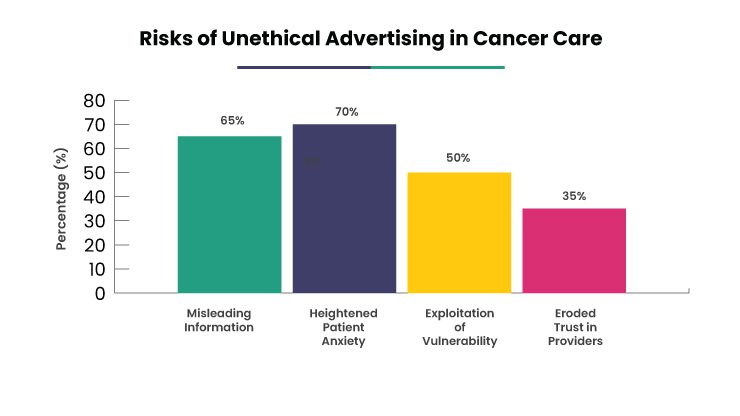
Ethical Guidelines for Creating Responsible Oncology Ads
To build trust and ensure compliance with healthcare marketing norms, oncology practices should adopt the following guidelines:
1. Center the Message on Education, Not Persuasion
Ethical ads aim to inform, not convert. Provide details that help patients evaluate whether your facility is right for them.
Use this:
“Explore personalized cancer treatment options guided by specialists.”
Avoid this:
“Act now- limited slots for miracle therapy!”
2. Respect Emotional Boundaries in Language and Imagery
Avoid dramatized photos of suffering or extreme medical visuals. Instead, choose warm, respectful, and realistic imagery- patients and clinicians in genuine interaction, not staged drama.
3. Ensure Scientific Accuracy
If you promote treatments like immunotherapy, CAR-T, or robotic surgery, include:
- Who the treatment is intended for
- Common side effects
- FDA/ICMR approval status
- Links to peer-reviewed studies
Accuracy matters more than attention-grabbing headlines.
4. Obtain Informed Consent for Testimonials and Images
Always seek documented permission before featuring a patient or family member. Make them aware of where and how their story will be used. Never present a testimonial as spontaneous if it was prompted, edited, or incentivized.
5. Comply with Local Laws and Platform Policies
- In India, follow NMC and ICMR guidelines on medical advertising.
- Google restricts targeting ads based on sensitive health terms (e.g., cancer type).
Facebook’s healthcare ad policies disallow before-after imagery and emotionally manipulative language.
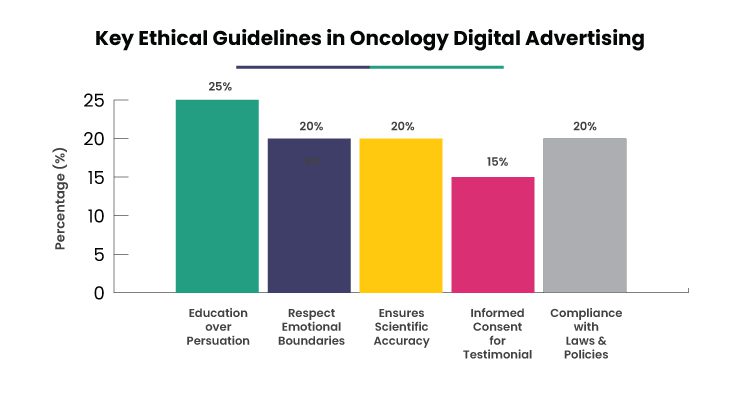
Ethical Formats for Digital Oncology Advertising
Different digital advertising formats can be used ethically in oncology, each with its own best use case and specific considerations.
Google Search Ads are ideal for appearing in high-intent search queries like “best oncologist near me.” These should use factual, service-based language and provide links to detailed information to help patients make informed choices.
Facebook Lead Ads work well for promoting cancer awareness initiatives such as webinars or second-opinion services. It’s essential to always offer an opt-out option and clearly state that the content is informational, not diagnostic, to avoid misleading patients.
YouTube Ads are effective for sharing explainer videos about treatments or patient journeys. Care should be taken to ensure thumbnails and video previews are not sensationalized, maintaining a respectful tone.
Email Campaigns are suitable for distributing recovery tips, follow-up care reminders, or emotional support resources. These campaigns must include unsubscribe links and comply with privacy regulations like GDPR or HIPAA, to protect patient data and maintain trust.
Balancing Metrics with Morality: What Should You Measure?
Digital campaigns rely on KPIs like click-through rate (CTR), cost-per-lead (CPL), and conversions. But in oncology, those numbers should always be interpreted through an ethical lens.
In addition to standard metrics, track:
- Emotional Tone of Engagement: Are people leaving anxious or appreciative comments?
- Feedback on Ads: Run quick polls or feedback forms to ask if viewers found the information helpful.
- Educational Impact: Track downloads of cancer guides, event attendance, or time spent on information pages.
- Conversion Quality: Are patients coming in well-informed or confused? The former suggests your ad strategy is ethically sound.
“Every click might represent someone facing the hardest moment of their life- respect that in your metrics.”
Case Example: Ethical Campaign for Breast Cancer Awareness
Hospital: A tertiary care cancer hospital in Delhi
Goal: Raise awareness about early detection and female oncology services
Strategy:
- Launched social media ads in Hindi and Punjabi
- Promoted free mammogram camps and live Q&A with female oncologists
- Avoided terms like “life-saving” in ads; used “know your options” instead
- Testimonials from survivors included notes like: “Every case is unique. Consult your doctor.”
Results:
- 4,000+ registrations for screening
- 700+ views of the live Q&A
- 85% of attendees said the campaign made them feel “supported, not scared”
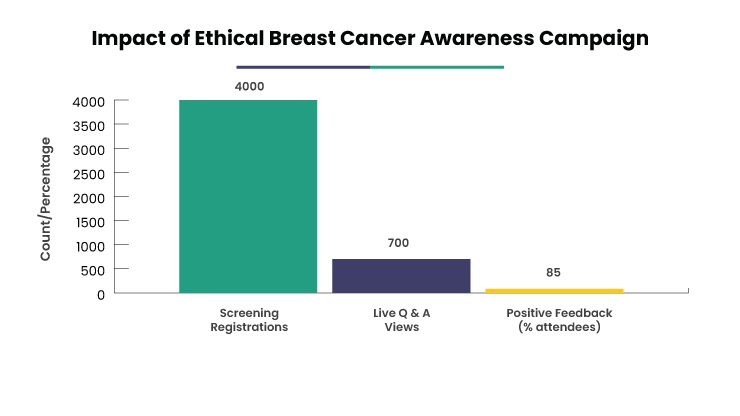
Takeaway: Culturally sensitive, non-alarmist messaging still converts ethically.
Overcoming Challenges in Ethical Oncology Marketing
Even when intentions are right, practices may struggle with implementation. Common barriers include:
- Limited marketing expertise in medical teams
- Budget pressures to prioritize quick leads
- Outsourcing to agencies unfamiliar with healthcare sensitivities
Suggested Solutions:
- Train your marketing team in basic medical ethics
- Use checklists before publishing content (tone, imagery, claims)
- Collaborate with healthcare-specialized marketing firms
- Establish a review board involving doctors and legal advisors
Conclusion: Make Ethics Your Practice’s Brand Identity
In oncology, digital visibility isn’t about making the most noise- it’s about making the right impact. Ethical advertising respects patient dignity, builds trust, and enhances your brand’s credibility in the long term.
Every ad should echo your practice’s core mission: healing with honesty, supporting with sensitivity, and serving with science.

